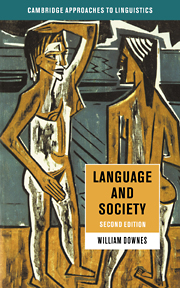Book contents
- Frontmatter
- Contents
- Acknowledgements
- 1 Linguistics and sociolinguistics
- 2 A tapestry in space and time
- 3 Language varieties: processes and problems
- 4 Discovering the structure in variation
- 5 Rhoticity
- 6 At the intersection of social factors
- 7 Change, meaning and acts of identity
- 8 The discourse of social life
- 9 Communication: words and world
- 10 Action and critique
- 11 Language and social explanation
- Further reading
- References
- Index
2 - A tapestry in space and time
Published online by Cambridge University Press: 05 June 2012
- Frontmatter
- Contents
- Acknowledgements
- 1 Linguistics and sociolinguistics
- 2 A tapestry in space and time
- 3 Language varieties: processes and problems
- 4 Discovering the structure in variation
- 5 Rhoticity
- 6 At the intersection of social factors
- 7 Change, meaning and acts of identity
- 8 The discourse of social life
- 9 Communication: words and world
- 10 Action and critique
- 11 Language and social explanation
- Further reading
- References
- Index
Summary
We must be careful not to overrate the uniformity of existing languages; it is far enough from being absolute. In a true and defensible sense, every individual speaks a language different from every other.
Whitney (1875)Sociolinguistics was defined in the last chapter as the branch of linguistics which studies the properties of language which require reference to social factors for their explanation. One such property is variation. We recognize many different ‘ways of speaking’ the same language; for example, speakers with different dialects or accents. Sometimes we get variation within the same community between two distinct languages; for example, between French and English. In this first part of the book, we shall examine such largescale patterns of variation.
But first notice that both of these examples of variation presuppose that we know what a language is. This is not as easy a question as it sounds. In fact, the title of this chapter is not a bad metaphor for the sort of entity in question.
The question, ‘What is a language?’
The question, ‘What is a language?’ is not the same as the question, ‘What is language?’ In the former case we are asking about the nature of particular languages, ‘the English language’ or ‘the French language’ etc. We shall see that in this case the answer proves, surprisingly, to be at least partially social. To the latter question, the answer is largely a psychological one.
- Type
- Chapter
- Information
- Language and Society , pp. 16 - 45Publisher: Cambridge University PressPrint publication year: 1998



